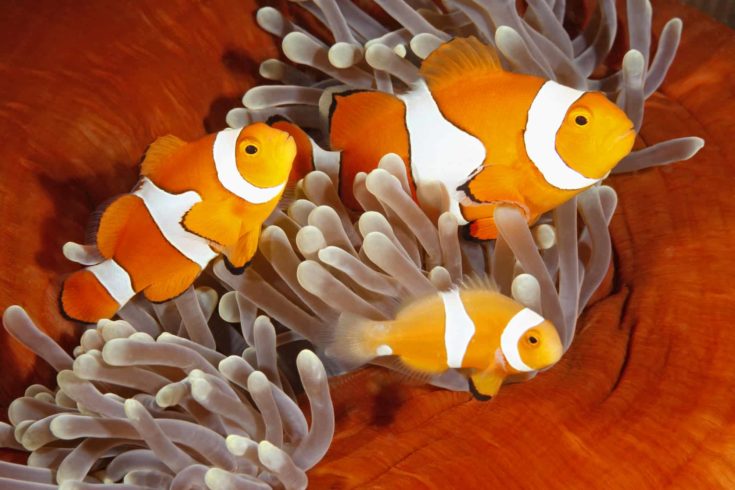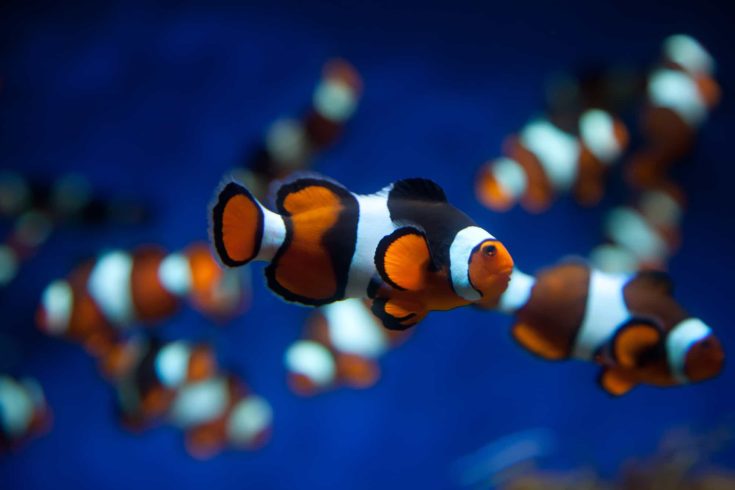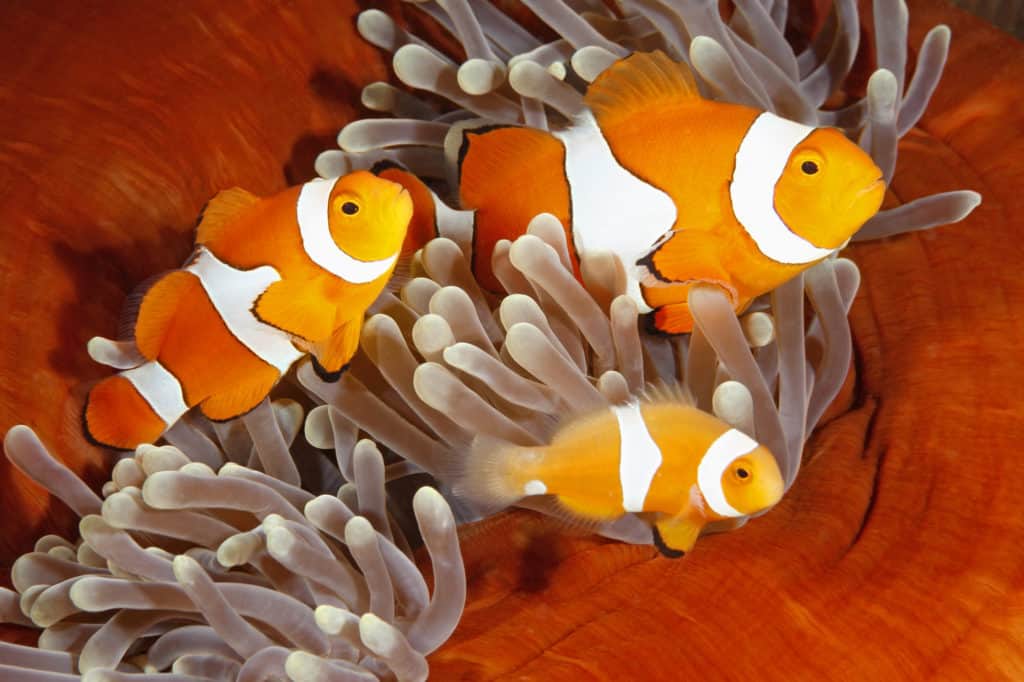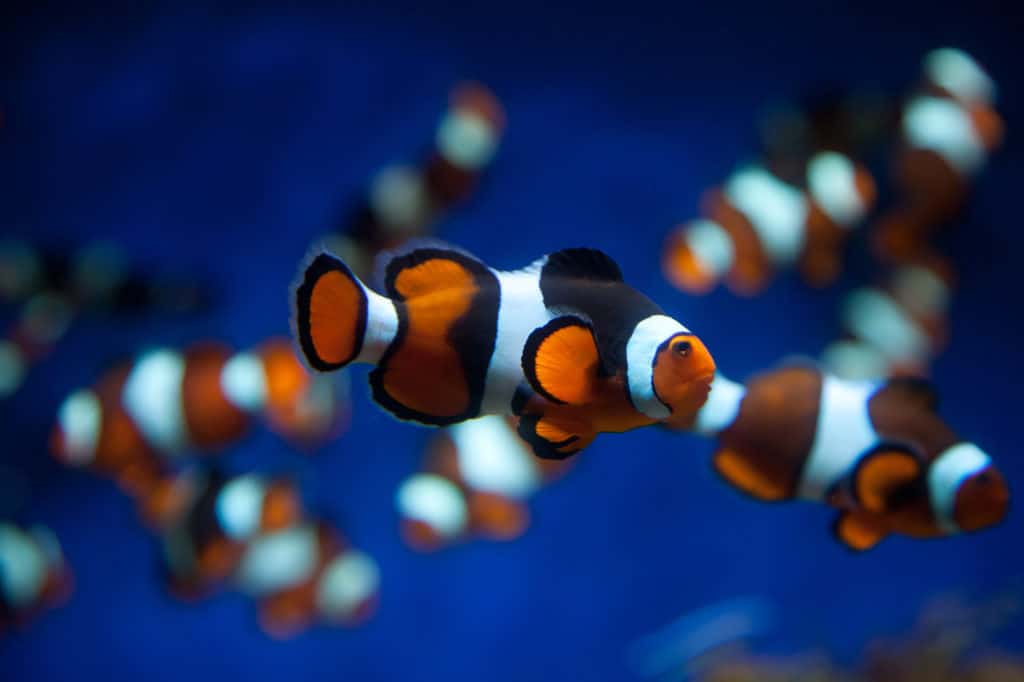Clownfish are one of the most popular marine species. Not only are these fish colorful and attractive to look at, but they are also relatively inexpensive to buy and straightforward to care for, making them an excellent choice for beginners.
Did you know that there are almost 30 species of clownfish, many of which can be kept in the home aquarium?
In this guide, we compare the Percula vs. Ocellaris clownfish.
What Is The Difference Between The Percula and Ocellaris Clownfish?
The Ocellaris clownfish has the scientific name Amphiprion ocellaris. This fish has thin black outlining around its white bands, 11 dorsal spines, and is dark-colored around the eyes. The Percula clownfish, scientific name Amphiprion percula, has more orange coloration around its eyes that can be more prominent than in Ocellaris, ten dorsal spines, and thicker black outlining around its white bands.
It’s not true that one species is wild-caught while the other is exclusively tank-raised. Both species can be captive-bred or taken from nature.
Comparison Table
Ocellaris Clownfish

Appearance
Orange with thin black-bordering around its white bands
4.3 inches long
Water Conditions
Specific gravity 1.021 to 1.026pH: 8.0 to 8.4
Temperature
75° to 80° Fahrenheit
Lifespan
Up to 6 years
Percula Clownfish

Appearance
Orange with thick black-bordering white bands
Up to 3 inches long
Water Conditions
Specific gravity 1.021 to 1.026pH: 7.8 to 8.4
Temperature
72° to 78° Fahrenheit
Lifespan
Up to 6 years
- Clownfish are divided into subgroups, commonly referred to as “complexes.” Ocellaris and Percula clownfish are the only species that belong to the Percula complex.
- The Ocellaris clownfish is also called the False clownfish.
- The Percula clownfish is also referred to as the True clownfish.
- Ocellaris and Percula are two different species of clownfish, although they both belong to the same family, Pomacentridae.
- Ocellaris and Percula both live for around six years in captivity and grow to a similar size, although the Percula clownfish is slightly smaller.
- Both fish share similar water parameters and temperature requirements.
- The Ocellaris clownfish has dark coloring around its eyes, 11 dorsal spines, and thin black borders around its white bands.
- The Percula clownfish, or True clownfish, has more orange color around the eyes, ten dorsal spines, and thick black outlining around the white bands.
- Both species of clownfish can be tank-bred or wild-caught.
Comparing Ocellaris And Percula Clownfish
In this part of our comparison guide, we take a closer look at both species, their similarities, and their differences.
The Ocellaris Clownfish
First of all, let’s discuss the Ocellaris or False clownfish.
Origins And Distribution
Ocellaris clownfish are native to the ocean waters around the Nicobar and the Andaman Islands of the Andaman Sea, Philippines, Indo-Malayan Archipelago, the coast of southeast Asia north to the Ryukyu Islands, and northwestern Australia.
Habitat
The Ocellaris clownfish lives in small groups in sheltered lagoons or on outer reef slopes up to a maximum depth of around 50 feet. The fish has a symbiotic relationship with three different species of sea anemones:
- Heteractis magnifica
- Stichodactyla gigantea
- Stichodactyla mertensii
The anemones provide the fish with protection from predators, and the clownfish removes parasites from the anemone and provides it with protection from some species of reef fish that might eat the anemone’s tentacles.
Appearance
Ocellaris clownfish grow up to 4.3 inches in length. The fish are oval-shaped and stocky-bodied with 11 dorsal spines and a taller caudal fin than the Percula clownfish.
The fish’s body color is reddish-brown or orange, although there are black variants in some locations, such as in the Northern Territory of Australia. There are three vertical white bands across the fish’s body outlined with a fine black line. The first band passes behind the fish’s eye, the second comes across the center of the body, widening toward the head, and the last forms a circle around the peduncle.
All the fins are outlined with a fine black line.
Social Behavior
Clownfish are active during the daytime, living in small groups within which is a distinctive hierarchy. The fish are aggressively territorial, defending their chosen sea anemone.Ocellaris clownfish are protandrous hermaphrodites. That means that the male fish can change sex to become female. That quirk of nature means that in a group of all males, some change sex so that reproduction can take place.
Diet
Both species of clownfish share a similar diet. In nature, the fish eat small crustaceans, such as amphipods and copepods, polychaete worms, algae, and their host anemone’s leftovers.
In the aquarium, clownfish can be fed pellets, Mysis shrimp, flake foods, and frozen brine shrimp.
Tank Mates
Although territorial with their own species, Ocellaris clownfish can live harmoniously with dartfish, angelfish, damselfish, tangs, wrasses, blennies, puffers, and gobies. They are also coral-safe.
Interestingly, tank-kept clownfish don’t need an anemone to host them.
Breeding
Clownfish are egg-layers, and unlike many marine fish species, it’s relatively easy to breed Ocellaris clownfish, provided that you have a mated pair.
The Percula Clownfish
Now, let’s take a look at the Percula clownfish.
Origins And Distribution
Percula clownfish come from the Indo-Pacific region, ranging from Northern Queensland in Australia to Melanesia, New Guinea, New Britain, the Solomon Islands, New Ireland, and Vanuatu.
Habitat
Like its look-alike cousin, the Ocellaris clownfish, the Percula clownfish lives in tropical lagoons and reefs at a depth of three to 49 feet.
Percula clownfish also form symbiotic relationships with anemones, specifically, Heteractis crispa and Heteractis magnifica on outer reefs and Sticholdactla gigantea on on-shore reefs.
Appearance
Percula clownfish also grow up to 3 inches in length. The fish are oval-shaped and stocky-bodied with ten dorsal spines.
The fish’s body color is orange, with three vertical white bands outlined with a thick black line, and all the fins are similarly outlined in black.
Social Behavior
The Percula clownfish is considered to be semi-aggressive, although they are generally more belligerent than the Ocellaris clownfish. In a tank setting, Percula clownfish will not tolerate others of their own species, unless part of a mated pair. The fish tend to be more mellow when kept without an anemone since that can trigger territorial behavior.
Diet
Ocellaris and Percula clownfish eat a similar diet in the wild and in a tank environment.
Tank Mates
You can keep Percula clownfish with other peaceful species that are not large enough to swallow it whole, such as tangs and wrasses, as long as you provide plenty of hiding places.
You should not keep Percula clownfish with species of clowns from the Clarkii complex, Tomato complex, or Maroon complex. Those types are too aggressive to be kept with other clowns or even with conspecifics.
Breeding
As with Ocellaris clownfish, it’s relatively easy to breed Percula clownfish, provided that you start with a mated pair.
Stand Out Features
- Clownfish are categorized into subgroups that are known as “complexes.” Ocellaris and Percula clownfish are the only species that belong to the Percula complex.
- Ocellaris and Percula clownfish look very similar, although there are notable differences. Ocellaris are slightly larger than Percula and have a more upright dorsal fin. Also, Ocellaris have finer black outlines around their white banding.
- Both species come from a similar habitat. In the wild environment, Ocellaris and Percula clownfish need an anemone in which to take shelter. The relationship is symbiotic in that they both offer each other protection from aggressive reef residents. The fish also provides the anemone with scraps of food that it drops.
- It is possible to breed both species in the aquarium, provided that the environment is set up correctly and you have a mated pair.
- Both these species of clownfish are semi-aggressive, although the Percula clownfish is slightly less belligerent than the Ocellaris. You can only keep these clowns in mated pairs and not with other species of clownfish.
- Ocellaris and Percula clownfish eat a similar diet both in captivity and in the wild environment.
- Both Percula and Ocellaris clownfish are relatively easy to care for and make a good starter fish for those beginning their marine and reef-keeping journey.
In Conclusion
I hope you enjoyed our guide to the differences between Ocellaris and Percula clownfish. If you found the information that we’ve provided helpful, please share this article.
So, both these species of clownfish look very similar and are the only ones that are categorized as Percula complex clowns. Both species are easy to care for and make a good choice for a beginner to keeping marines. The Ocellaris is slightly larger than the Percula clown and has slightly different conformation and markings.
Do you have clownfish? What species do you keep, and have you bred them successfully in your aquarium?
Tell us in the comments box below!

